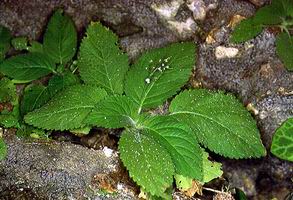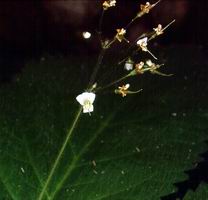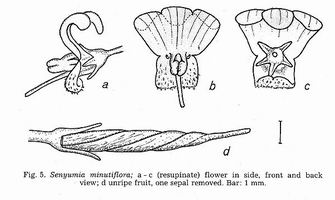

Penins. Malaysia, Pahang, G. Senyum, phot. A. Weber (1986)
Full name and orig. publication: Senyumia Kiew, A. Weber & B.L.Burtt, Beitr. Biol. Pflanzen 70 (2-3): 400 (26 Nov. 1998, "1997").
Etymology: The name refers to the the locality of the only species, Gunung Senyum, in Peninsular Malaysia.
Synonyms: -
Infrafamilial position: Didymocarpoid Gesneriaceae - "Advanced Asiatic and Malesian genera" (Weber 2004).
Description: Small perennial herb. Stem decumbent, somewhat woody, woolly-hairy. Leaves opposite, tufted, petiole rather short, lamina thin-membranous, broadly lanceolate to ovate, margin coarsely serrate, teeth blunt, long hairy on both sides. Cymes with slender peduncle and several flower pairs in dichasial arrangement. Flowers resupinate. Sepals 5, linear-lanceolate, free to base. Corolla pure white, with short tube and large, bilabiate limb, lobes reflexed. Stamens 2, with short filaments and large, yellow, cohering anthers. Nectary absent. Ovary ovoid. Capsule spirally twisted, opening dorsally and ventrally. Seeds with reticulate testa.
Chromosome number: 2n = 18.
Type and only species: Senyumia minutiflora (Ridl.) Kiew, A.Weber & B.L.Burtt
Species names (incl. publication and synonyms): See Skog, L.E. & J.K. Boggan. 2005: World checklist of Gesneriaceae: http://persoon.si.edu/Gesneriaceae/Checklist.
Distribution: Malay Peninsula (Pahang: Gunung Senyum and adjacent localities).
Ecology: On rock faces in damp limestone caves.
Notes: The only species was originally described as Boea minutiflora Ridl. Remarkable is the resupinate white and widely open flower with a yellow anther cone in the center (syndrome of an oligandric pollen flower).
Bibliography: See Skog, L.E. & J.K. Boggan. 2005. Bibliography of the Gesneriaceae. 2nd edition: http://persoon.si.edu/Gesneriaceae/Bibliography.
Illustrations:
 |
 |
Senyumia minutiflora (Ridl.) R. Kiew, A. Weber & B.L. Burtt, only
species
Penins. Malaysia, Pahang, G. Senyum, phot. A. Weber (1986) |
 |
Senyumia minutiflora (Ridl.) R. Kiew, A. Weber & B.L. Burtt
Flower and fruit; Beitr. Biol. Pflanzen 70: 391, fig. 5 (1998) |
last modified: 2007-07-13